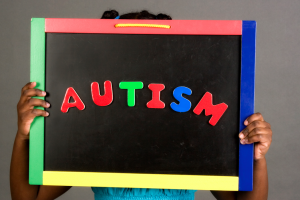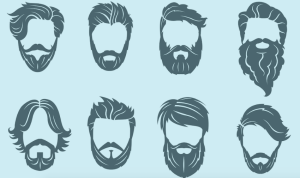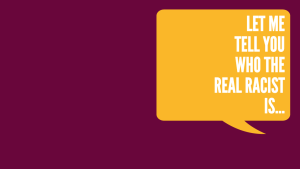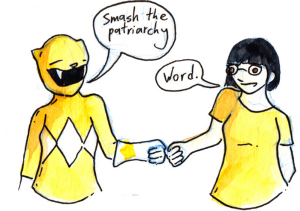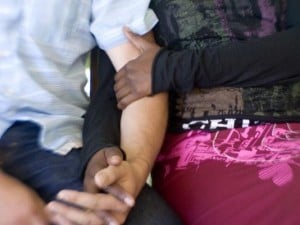
A person stands in front of a blue background, holding up a speech bubble with the word “NO.” Image courtesy of Thinkstock; text added by EF.
(Content notice: anti-trans/non-binary aggression, cissexism)
As cliché as it sounds, I always knew I was “different.”
I would look at the other boys during recess and think, I know I’m supposed to be like that, and then I would look at the girls and think, But I actually identify more with that. Yet I also never felt any extreme discomfort with my body during puberty, except for my excessive body hair.
I just assumed I had an androgynous personality, and that was it.
Then a few years ago, I saw a video from Verity Ritchie, one of my favorite YouTubers, who described their non-binary gender identity as “being both a boy and a girl at the same time.” Ritchie currently identifies as a genderqueer trans woman.
But at the time of this video, I thought, Wait, there’s a word for that?
I started exploring my gender then, eventually coming out as a genderqueer/non-binary trans person a year later.
Since then, I’ve had the opportunity to start a lot of conversations among my friends about what it means to be non-binary. I’ve gone on my fellow atheist podcasters’ shows shows to talk about it. I’m even going to present a Non-Binary 101 talk at the 2017 American Humanist Association Annual Conference.
Although genderqueer and non-binary identities are relatively new concepts for folks, most people I come across are pretty open-minded and willing to learn, which is really encouraging and validating!
However, there are still some who want to write off anything that doesn’t fit the binarist view of gender as “made up.”
If it’s not outright assholes, then it’s microaggressions and self-flagellation from would-be allies. And microaggressions – seemingly small offenses that marginalized people encounter in their everyday lives – are also painful.
Maybe I’m being too nice, but I like to give people the benefit of the doubt – to believe that those who are committing microaggressions don’t mean to, and would stop if only they knew that what they’re doing is harmful.
So I made a list of common microaggressions I hear, in hopes of furthering the education of the masses.
Share this so that others can learn too!
1. ‘Isn’t That Something Tumblr Made Up?’
While it’s true a lot of non-binary people may have found out about non-binary gender identities through Tumblr, the whole idea that Tumblr “invented” the concept is crap.
The truth is that many cultures have embraced non-binary genders throughout the centuries, including the Native American Two-Spirit and the South Asian Hijra.
Also, the earliest known use of the word genderqueer was in a 1995 newsletter by Riki Wilchins. Sure, 1995 may not have been all that long ago – but Tumblr definitely wasn’t a thing yet!
In the 2002 anthology, Genderqueer: Voices from Beyond the Sexual Binary, Wilchins went on to explain that the term is meant to be an umbrella term for gender non-conformists excluded by the trans community:
Gender itself remains invisible as a progressive issue. If it is mentioned at all, it is carefully confined to transgender.
So despite what critics say, the concept of non-binary genders, gender fluidity, and/or gender non-conformity didn’t just come out of the blue one day by a bunch of bored teenagers on Tumblr.
It’s an old idea that’s just now getting recognition.
2. ‘So, Are You Gonna Have The Surgery?’
Don’t. Just don’t, okay?
As my friend Callie often says, the only people who need to know about my genitals are my primary doctor and my sexual partner(s).
3. ‘Penis = Boy and Vagina = Girl – Get Over It!’
Oh boy, here we go again with another Transgender 101 lesson!
The sad part is that I hear this a lot from self-described skeptics who say they get all their information from science.
I guess they overlooked the body of evidence that shows a neurological basis for gender identity.
The most recent (that I know of) came in January of 2015 from the Medical University of Vienna.
Using MRT brain scans on men and women – both cis and trans – they found “significant differences in the microstructure of the brain connections between male and female control subjects. Transgender persons took up a middle position between both genders.”
Or as writer Amanda Koehn explains:
A trans woman has significantly different brain movement than a cis man, despite having the same biological sex. Moreover, trans men and trans women were different from each other, implying that the brain shows a wide range of gender based differences, rather than simply male or female.
Also, by reducing gender to just genitals and chromosomes, where does that leave intersex people?
4. ‘Science Says There Are Only Two Genders!’
Ah, now here’s where things get complicated.
We just established that there’s a scientific basis for binary gender identities, but right now there’s not a lot of literature on a scientific basis for non-binary gender identities.
The closest one I found was a 2012 study published in Medical Hypotheses.
In the study, Laura K. Case and Vilayanur S Ramachandran created an online survey posted in a group for people who identify as bigender. Out of the 32 participants, 14 participants reported involuntarily “switching” their gender identities daily, nine weekly, six monthly, and four several times a year.
The study also reveals that almost two-thirds of “bigender respondents reported experiencing phantom body parts and rated them as moderate in strength.”
Case and Ramachandran reiterate that these cases of gender fluidity and phantom body parts happen involuntarily, so it’s not just “wishful thinking.”
Naturally, more research is needed, and the article does medicalize non-binary people in a way. However, given the evidence of a scientific basis for binary gender identities, Case and Ramachandran’s study suggests that maybe there’s one for non-binary gender identities as well.
5. ‘You’re Not Trans! You’re Just Trying to Get Attention!’
I recently got into a semi-heated argument with a trans friend who isn’t convinced non-binary belongs under the trans umbrella because, hey, what exactly are non-binary folks transitioning to, if not a man or a woman?
However, the DSM-5 describes gender dysphoria in a way that’s inclusive to non-binary people – because it refers to “an alternative gender different from one’s assigned gender,” rather than only the “other gender” in the binary.
Thus, according to gender therapist Christina Richards, non-binary people can fall under the trans umbrella. Also, Richards adds that “it is likely that some people who previously would have identified as trans – that is within the gender binary, but moving across it – may have identified outside of the binary if that discourse had been available to them.”
I should point out, though, that not all non-binary people pursue medical transition. However, not all binary trans people transition either.
Also, as gender therapist Dara Hoffman Fox said on my podcast, not all genderqueer and non-binary people feel comfortable identifying as trans.
I personally identify as trans, though, because during a recent session with my gender therapist, I admitted that I often look at women and wish I looked more like them. I also told her I feel extreme discomfort with my body hair – which is quite bountiful, since part of my ethnicity is Italian – and I’m seriously considering laser hair removal.
My gender therapist said, “You’re definitely not a cis. Cis men aren’t uncomfortable with their body hair. Cis men don’t look at beautiful women and want to look like them.”
That was a huge relief for me because, up until then, I thought I was just a cis man trying to appropriate trans language to be hip and cool.
Good to know that’s not the case!
6. ‘But They Is Plural!’
Actually, according to NPR, the singular use of they was common until the Victorian era:
By using he as the standard gender-inclusive pronoun, it still said “male” is the norm, so the singular they came back.
(But don’t tell that to Jordan Peterson.)
7. ‘OMG! I Used the Wrong Pronoun! I’m So Sorry! I’m a Terrible Person!’
Look, I get it. You want to be a good ally and not erase someone’s identity, even if it’s by accident.
I appreciate the apologies, but I can’t stand groveling: You’re basically centering yourself and your feelings.
Just say “I’m sorry,” and then move on.
And I say this from personal experience, too. I’ve groveled before marginalized people after saying or doing something problematic. They let me know quickly I was making everyone use their limited spoon supply to dig me out of the dumps.
Having said that, though, I prefer someone who accidentally refers to me as “he” – but would still protect me from harm – than someone who uses my pronouns but does nothing when people try to harm me.
8. ‘I’m Trying So Hard, But the Singular They Is Just Too Much!’
Gee, I’m so sorry that doing a basic thing like using the right pronouns for me is so hard for you. Let me play a tiny violin.
Seriously, I don’t need your tears.
As I said before, if you mess up, that’s okay, but I don’t need groveling.
I don’t need you to focus the conversation on yourself and your feelings.
9. ‘Special Snowflake!’
No. Just no.
***
So there you have it, folks!
Hopefully this little guide clears some things up. I don’t expect everyone to “get it” right away, which is why I’m always willing to talk about what it means to be non-binary.
However, starting conversations with these nine things usually doesn’t help.
[do_widget id=’text-101′]
Trav Mamone is a bisexual genderqueer freelance writer who blogs about the intersections of secular humanism and social justice at Bi Any Means. They also host the Bi Any Means podcast and co-host the Biskeptical podcast. Follow them on Twitter @tmamone.
Search our 3000+ articles!
Read our articles about:
Our online racial justice training
Used by hundreds of universities, non-profits, and businesses.
Click to learn more





